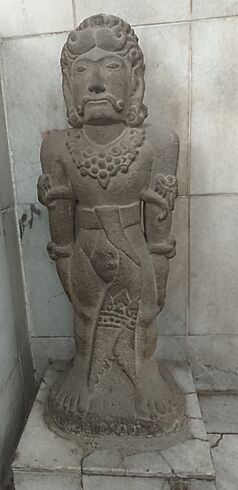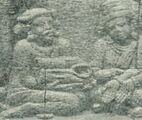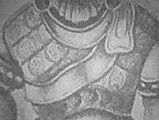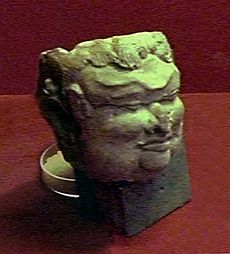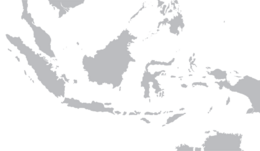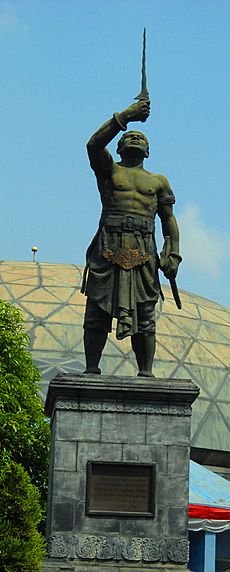Gajah Mada facts for kids
Quick facts for kids
Gajah Mada
ꦓꦗꦃꦩꦢ Mahapatih
|
|
|---|---|
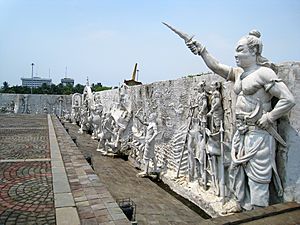
A popular depiction of Gajah Mada in the National Monument
|
|
| Mahapatih of the Majapahit Empire | |
| In office 1331 – c. 1364 |
|
| Monarch | Jayanegara Tribhuwana Wijayatunggadewi Hayam Wuruk |
| Personal details | |
| Born | c. 1290 |
| Died | c. 1364 |
| Religion | Shiva-Buddha |
| Military service | |
| Battles/wars | Sadeng Rebellion Ra Kuti Rebellion Bedahulu War Battle of Bubat Padompo |
Gajah Mada (around 1290 – around 1364) was a very powerful military leader. He was also the mahapatih, which is like a prime minister, of the Majapahit kingdom. This Javanese kingdom was very important in the 14th century. Many old Javanese writings say that he helped the empire become very strong and famous.
Gajah Mada made a special promise called the Sumpah Palapa. He swore he would not rest until he had united all the islands of Nusantara under Majapahit's rule. During his time, Hindu stories like the Rāmāyana and Mahābhārata became very popular. They were often told through wayang kulit (shadow puppet shows). Today, Gajah Mada is seen as an important national hero in Indonesia. He stands for national pride and unity. We learn about him from old books like the Pararaton and the Nagarakretagama.
Contents
How Gajah Mada is Shown
- Brajanata statue, at the National Museum of Indonesia, No. 5136/310d
- Bima statue, No. 2776/286b
Many modern pictures of Gajah Mada come from a book by Mohammad Yamin in 1945. Yamin visited Trowulan, which was once the capital of Majapahit. He found a small clay piggy bank shaped like a man's face. Yamin thought this face might be Gajah Mada. He asked an artist, Henk Ngantung, to paint it. This painting was used on his book cover.
However, many people don't agree with Yamin. They think it's unlikely that such a great leader's face would be on a piggy bank. Important leaders were usually shown in grand statues. Some even joked that the face looked like Yamin himself!
Another idea about Gajah Mada's appearance comes from archaeologist Agus Aris Munandar. He believes Gajah Mada was shown as Bima in wayang puppet shows. Bima is a strong hero with a mustache. In popular art, Gajah Mada often appears bare-chested, wearing a sarong, and holding a kris (a type of dagger). But his official clothes might have been different. An old story says he wore a gold chest plate and carried a gold spear and a shield with diamonds.
Munandar also suggests that Gajah Mada was first shown as a character called Brajanata. Later, he was shown as Bima from the Mahābhārata stories. The Bima statues linked to Gajah Mada were made later in Majapahit's history. These statues show Bima with a special crown, a strong body, and a black and white cloth.
What His Name Means
The name "Gajah" means "elephant." Elephants are big, respected animals. In Hindu stories, the god Indra rides an elephant. Elephants are also linked to Ganesha, the elephant-headed god.
The word "Mada" in old Javanese means "drunk." When an elephant is "drunk," it walks strongly and overcomes anything in its way. So, Gajah Mada's name can mean two things:
- He was like a vehicle for the king, carrying out the king's orders. This is like the elephant Airavata carrying the god Indra.
- He was a strong person who would overcome any problems that blocked the kingdom's progress. His name seems to have been chosen very carefully.
Gajah Mada also had another title: Rakryan Mapatih Jirnnodhara. This title might have been his official name. Jirnnodhara means "builder of something new" or "restorer of something broken." Gajah Mada built a temple for King Kertanegara. He also helped bring back Kertanegara's ideas for uniting the islands.
How Gajah Mada Became Powerful
We don't know much about Gajah Mada's early life. He came from an ordinary family. He started his career as a commander of the Bhayangkara. These were special royal guards for the Majapahit king.
In 1321, an official named Rakrian Kuti rebelled against King Jayanegara. Gajah Mada helped the king escape the capital city, Trowulan. Later, Gajah Mada helped the king return and stop the rebellion. Seven years later, King Jayanegara died.
Jayanegara's half-sister, Tribhuwana Wijayatunggadewi, became queen in 1328. When she took the throne, some regions, Sadeng and Keta, rebelled. Gajah Mada was a patih (an official) at this time. He was sent to talk with the rebels. However, another general, Ra Kembar, attacked the rebels first. This caused a conflict between Gajah Mada's and Ra Kembar's forces. The queen herself had to step in to stop the fighting and defeat the rebels.
After the old prime minister retired, Gajah Mada was chosen as the new mahapatih in 1334. Around 1345, a famous traveler named Ibn Battuta visited Sumatra during Gajah Mada's time as prime minister.
The Palapa Oath and Empire Growth
When Gajah Mada became mahapatih under Queen Tribhuwanatunggadewi, he made his famous Palapa Oath. This oath is written in the Pararaton book.
The oath says: Sira Gajah Madapatih amangkubhumi tan ayun amuktia palapa, sira Gajah Mada: "Lamun huwus kalah nusantara isun amukti palapa, lamun kalah ring Gurun, ring Seran, Tañjungpura, ring Haru, ring Pahang, Dompo, ring Bali, Sunda, Palembang, Tumasik, samana isun amukti palapa".
This means: Gajah Mada became prime minister but would not "enjoy rest." He swore, "If I have conquered the Nusantara Archipelago, then I will enjoy rest. If I have conquered Gurun, Seram, Tanjungpura, Haru, Pahang, Dompo, Bali, Sunda, Palembang, Tumasik (Singapore), then I will enjoy rest."
Even his friends doubted his oath at first. But Gajah Mada worked hard to unite Nusantara under Majapahit. He soon conquered Bedulu (in Bali) and Lombok in 1343. He then sent his navy to attack the old kingdom of Sriwijaya in Palembang. He made a Majapahit prince, Adityawarman, the ruler there.
He also conquered the first Islamic kingdom in Southeast Asia, Samudra Pasai. Gajah Mada also took control of Bintan, Tumasik (Singapore), Melayu (now Jambi), and Kalimantan.

When Queen Tribhuwanatunggadewi retired, her son, Hayam Wuruk, became king in 1350. Gajah Mada stayed as prime minister. He continued his military campaigns, expanding the empire to many more islands.
He brought most of the modern Indonesian islands under Majapahit control. This included not only Indonesia but also Singapore, Malaysia, Brunei, parts of the southern Philippines, and East Timor.
An old stone writing, the Gajah Mada inscription, from 1351 CE, says that Gajah Mada built a sacred temple. This temple was for the late King Kertanegara. This shows that Gajah Mada respected the king very much. Some historians think Gajah Mada might even have been Kertanegara's grandson.
The Bubat Incident
In 1357, the Sunda kingdom was the only one that didn't accept Majapahit's rule. King Hayam Wuruk wanted to marry Dyah Pitaloka Citraresmi, a Sundanese princess. Gajah Mada was sent to welcome the princess and her father at Bubat square in Trowulan.
Gajah Mada used this chance to demand that Sunda surrender to Majapahit. The Sunda King thought the marriage would create a new alliance. But Gajah Mada believed the princess should be a concubine, a sign that Sunda was giving in. This misunderstanding led to a fight, which became the Battle of Bubat. The Sunda King and his people were defeated and killed. It is said that the princess, Dyah Pitaloka Citraresmi, was so sad that she took her own life.
King Hayam Wuruk was very upset by this event. The people in Majapahit blamed Gajah Mada for being too harsh. Gajah Mada was removed from his position as prime minister. He spent the rest of his life in Madakaripura.
Death
Gajah Mada died quietly in 1364, when he was about 74 years old. King Hayam Wuruk felt that Gajah Mada had too much power. So, the king divided Gajah Mada's duties among four new ministers. This probably helped the king gain more control. King Hayam Wuruk was a wise leader and kept Majapahit strong. However, after Hayam Wuruk died, the Majapahit empire slowly became weaker.
Legacy
Gajah Mada's time as prime minister helped spread Hindu culture in Java. This process is sometimes called "Indianisation."
In Bali, a special mask dance drama about Gajah Mada has been performed for 600 years. The Gajah Mada mask is believed to bring peace and harmony.
Gajah Mada is very important for Indonesian nationalism. In the early 1900s, Indonesian leaders like Sukarno and Mohammad Yamin used Gajah Mada's oath as inspiration. They said that Gajah Mada showed that Indonesians could unite, even with many different islands and cultures. His efforts to unite the islands under Majapahit helped inspire Indonesians to fight for independence from Dutch rule.
In 1945, the first state university in Indonesia was built. It was named Universitas Gadjah Mada in honor of him. This university was important because it was the first to freely accept native Indonesians.
Indonesia's first telecommunication satellite, launched in 1976, was called Satelit Palapa. This name was chosen to show its role in connecting the many islands of Indonesia.
The Army Military Police Corps in Indonesia also uses Gajah Mada as their symbol. Many cities in Indonesia have streets named after him. There is even a brand of badminton shuttlecocks named Gajah Mada.
See also
- Gajah Mada inscription
- Negarakertagama
- Kejawèn
- Kidung Sunda
- Gadjah Mada University
- Jalan Gajah Mada and Jalan Hayam Wuruk
- Agama Hindu Dharma
- Hinduism in Indonesia
- Hinduism in Southeast Asia


